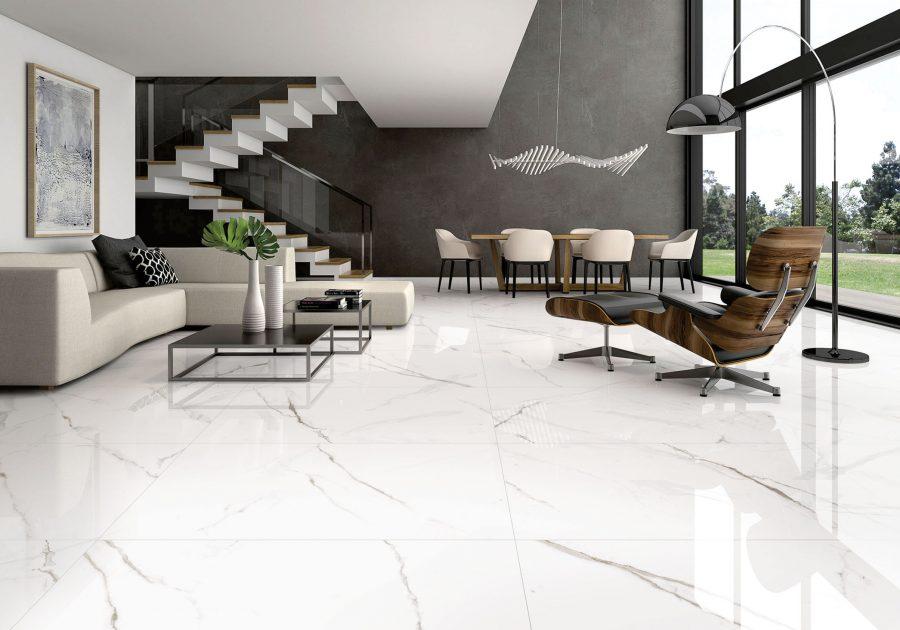When it comes to flooring, the material of the tile matters a lot, especially since Indian households tend to see fairly heavy foot traffic. Even otherwise, your home needs a base that is solid, durable – all while speaking of your personality through designs and patterns.
All these factors tied in one? Yes, it is possible!
In this case, ceramic and vitrified tiles are the clear contenders. However, although both are strong and bestselling tiles, they have their own set of differences, which we will see here. Before that, let’s check out this first.
What Are Ceramic Tiles?
Ceramic tiles are one of the most popular tiles that most homeowners go with. Besides their obvious popularity, these tiles have several aspects that make them perform great in the long run. Moreover, they are pretty easy to maintain for a long time. However, they can get damaged or cracked if any heavy object falls on them. Hence, if you have ceramic tiles at your place, a little care while moving or placing heavy objects should be borne in mind.
What Are Vitrified Tiles?
Vitrified tiles can be colloquially described as ceramic tiles that have undergone a vitrification process to become stronger and long-lasting. These tiles generally have a glossy appearance. However, as there is an additional manufacturing step involved in making vitrified tiles, they are expensive compared to ceramic tiles. Moreover, they can also get chipped at the sides.
Ceramic Vs Vitrified
There are some major differences between ceramic and vitrified tiles. Let’s have a look at some of them.
Properties
Ceramic tiles are made with natural clay, sand, and water, leading to a coarse surface. However, these tiles still have a low water absorption rate. They are available in glazed and unglazed options as per your choice.
Vitrified tiles, on the other hand, are less porous and stronger than pure ceramic tiles due to their vitrification process. The silica and clay used in this process are fused to form a glass-like element in each tile, which naturally gives them a glossy look. Consequently, they are generally available in a glossy finish.
Cost
Ceramic tiles make for an excellent budget tiling option, with their entire installation cost being affordable.
Vitrified tiles possess stronger characteristics than ceramic tiles due to vitrification. This enhancement manifests in the cost, as vitrified tiles are comparatively more expensive. However, this significant increase in pricing gives a value for money, with such excellent durability proving requisite for practical usage.
Durability
When it comes to durability, vitrified tiles stand out as they are stronger than other tiles. Having said that, while ceramic tiles may not reach the level of vitrified tiles, they still score higher on durability than most other tiles.
Installation
It is generally recommended that the installation of ceramic tiles in a Do It Yourself (DIY) manner should be avoided. Thus, these tiles should be installed by skilled professionals.
On the other hand, vitrified tiles, with their excellent strength and low probability of scratching or breaking, can be installed without the help of a skilled professional. However, it is always better to use a professional’s help as vitrified tiles require a stronger adhesive than ceramic. So whichever tile you go with, taking an expert’s help is always recommended.
Note: While installing the tiles, add spacers, which reduce the chances of air bubbles that bring down their shelf life. This simple step during installation will help your tiles stay for the longest time.
Appearance
When it comes to the appearance of the tiles, ceramic tiles tend to lean more towards earthen and natural looks. Compared to their vitrified counterparts, ceramic tiles lack a glossy texture. Instead, they have a slightly rough texture.
As vitrified tiles have a glossy finish, you don’t need any additional glazing as ceramic tiles do. However, due to this factor, they fail to fit in the ‘natural looking’ bracket.
In a nutshell, if you are looking for a durable tile for heavy foot-traffic areas, opt for vitrified tiles that are stronger in comparison. However, for other purposes, both ceramic tiles and vitrified tiles can function well. The bottom line here is the method of installation, on which the performance depends a lot. If any of these tiles are installed improperly, their longevity is hampered.
Author Bio:
Isha Tandon has worked within the architecture and interior design industry as a flooring consultant expert – specializing in tiles, stones, and terrazzo. She has worked with Orientbell Limited, a leading tile manufacturer in India, as a product development manager in the design team and has recently joined the marketing team as their digital content expert. Her experience comes in handy in understanding the audience as she creates value-driven functional & informational content for the readers. She creates lifestyle pieces that focus on interior design products, trends, and processes. She loves to travel to historic places with rich architecture.



